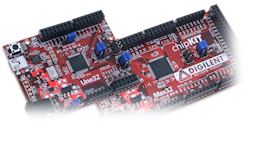In the previous work for the seven-segment, the VHDL code was written into one VHD file. In this case, the next assignment was to implement the concept of components into the seven-segment program. The way that component works, is that on a separate VHD file, the behavior of the VHD file must describe its purpose. In the top VHD file, we call the component, and then send the top VHD ports to the component, and finally receive back the information. In essence, a component is a block, and in the top VHD file, we implement that block, to use. It not only makes the code much cleaner, but it creates components that may be usable for other projects to use instead of repeating the same code over and over again.
seven_segment.vhd(TOP FILE)
library IEEE; --Libraries used
use IEEE.STD_LOGIC_1164.ALL;
use IEEE.STD_LOGIC_ARITH.ALL;
use IEEE.STD_LOGIC_UNSIGNED.ALL;
entity main is --Ports
port (
CLK: in std_logic; --FPGA 100MHz Clock
ANODE: out std_logic_vector(0 to 6); --Anodes for each seven segment (7 anodes)
LED: out std_logic_vector(3 downto 0); --Four LED lights representing bits
SEG: out std_logic_vector(7 downto 0) --Eight seven-segments
);
end main;
architecture Behavioral of main is --Behavior of seven segment after
component anode_comp is --Anode Component
Port (counter_in : in STD_LOGIC_VECTOR(26 downto 0);
anode_out : out STD_LOGIC_VECTOR(0 to 6));
end component;
component led_comp is --LED Component
Port (counter_in: in STD_LOGIC_VECTOR(26 downto 0);
led_out: out STD_LOGIC_VECTOR(3 downto 0));
end component;
component prescaler_comp is --Prescaler Component
Port (clock : in STD_LOGIC;
counter_out : out STD_LOGIC_VECTOR (26 downto 0));
end component;
signal COUNTER: std_logic_vector(26 downto 0); --Counter signal
begin
SEG <= "11111110"; -- Activate last seven-segment
prescale1: prescaler_comp --Send ports to prescaler_comp
Port Map (CLK,COUNTER); --Send CLK into component and receive COUNTER
anode1: anode_comp --send ports to anode_comp
Port MAP (COUNTER,ANODE); --Send COUNTER into component and receive ANODE
led1: led_comp --send ports to led_comp
Port MAP (COUNTER,LED); --Send COUNTER into component and receive LED
end Behavioral;
prescaler_comp.vhd
library IEEE; --Libraries used
use IEEE.STD_LOGIC_1164.ALL;
use IEEE.STD_LOGIC_ARITH.ALL;
use IEEE.STD_LOGIC_UNSIGNED.ALL;
entity prescaler_comp is --Ports
Port ( clock : in STD_LOGIC;
counter_out: out STD_LOGIC_VECTOR (26 downto 0));
end prescaler_comp;
architecture Behavioral of prescaler_comp is --Counter for PRESCALER and COUNT
signal counter: std_logic_vector(26 downto 0); --counter signal
signal prescaler: std_logic_vector (26 downto 0); --prescaler signal
begin
process(clock) --Process clock
begin
if rising_edge(clock) then --If clock is on rising edge
if prescaler < "101111101011110000100000000" then --If prescaler is less than 100M
prescaler <= unsigned(prescaler) + 1; --Add 1 to prescaler
else
prescaler '0'); --Clear prescaler
counter <= unsigned(counter) + 1; --Add 1 to counter
end if;
end if;
end process;
counter_out <= counter; --Send counter information into counter_out
end Behavioral;
anode_comp.vhd
library IEEE; --Libraries used
use IEEE.STD_LOGIC_1164.ALL;
use IEEE.STD_LOGIC_ARITH.ALL;
use IEEE.STD_LOGIC_UNSIGNED.ALL;
entity anode_comp is --Ports
Port ( counter_in : in STD_LOGIC_VECTOR (26 downto 0);
anode_out : out STD_LOGIC_VECTOR (0 to 6));
end anode_comp;
architecture Behavioral of anode_comp is --Behavior of anodes
begin
with counter_in select --When counter is equal to 'bits right of when statement', send bits to anode_out
anode_out (0 to 6) <= "0000001" when "000000000000000000000000000",
"1001111" when "000000000000000000000000001",
"0010010" when "000000000000000000000000010",
"0000110" when "000000000000000000000000011",
"1001100" when "000000000000000000000000100",
"0100100" when "000000000000000000000000101",
"0100000" when "000000000000000000000000110",
"0001111" when "000000000000000000000000111",
"0000000" when "000000000000000000000001000",
"0000100" when "000000000000000000000001001",
"0001000" when "000000000000000000000001010",
"1100000" when "000000000000000000000001011",
"0110001" when "000000000000000000000001100",
"1000010" when "000000000000000000000001101",
"0110000" when "000000000000000000000001110",
"0111000" when others;
end Behavioral;
led_comp.vdh
library IEEE; --Libraries used
use IEEE.STD_LOGIC_1164.ALL;
use IEEE.STD_LOGIC_ARITH.ALL;
use IEEE.STD_LOGIC_UNSIGNED.ALL;
entity led_comp is --Ports
Port ( counter_in : in STD_LOGIC_VECTOR (26 downto 0);
led_out : out STD_LOGIC_VECTOR (3 downto 0));
end led_comp;
architecture Behavioral of led_comp is --LED behavior
begin
with counter_in select --When counter is equal to 'bits right of when statement', send bits to led_out
led_out (3 downto 0) <= "0000" when "000000000000000000000000000",
"0001" when "000000000000000000000000001",
"0010" when "000000000000000000000000010",
"0011" when "000000000000000000000000011",
"0100" when "000000000000000000000000100",
"0101" when "000000000000000000000000101",
"0110" when "000000000000000000000000110",
"0111" when "000000000000000000000000111",
"1000" when "000000000000000000000001000",
"1001" when "000000000000000000000001001",
"1010" when "000000000000000000000001010",
"1011" when "000000000000000000000001011",
"1100" when "000000000000000000000001100",
"1101" when "000000000000000000000001101",
"1110" when "000000000000000000000001110",
"1111" when others;
end Behavioral;



